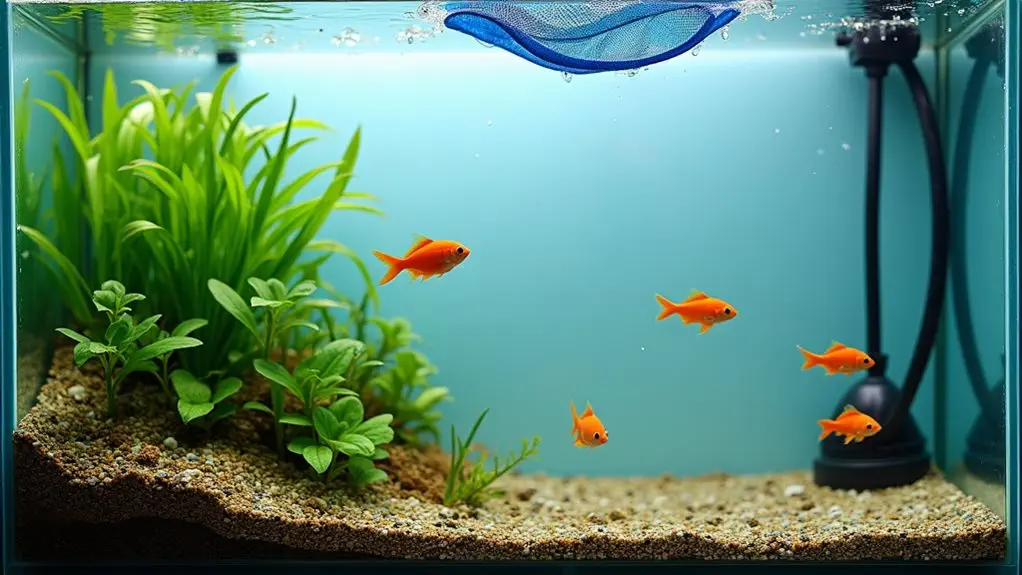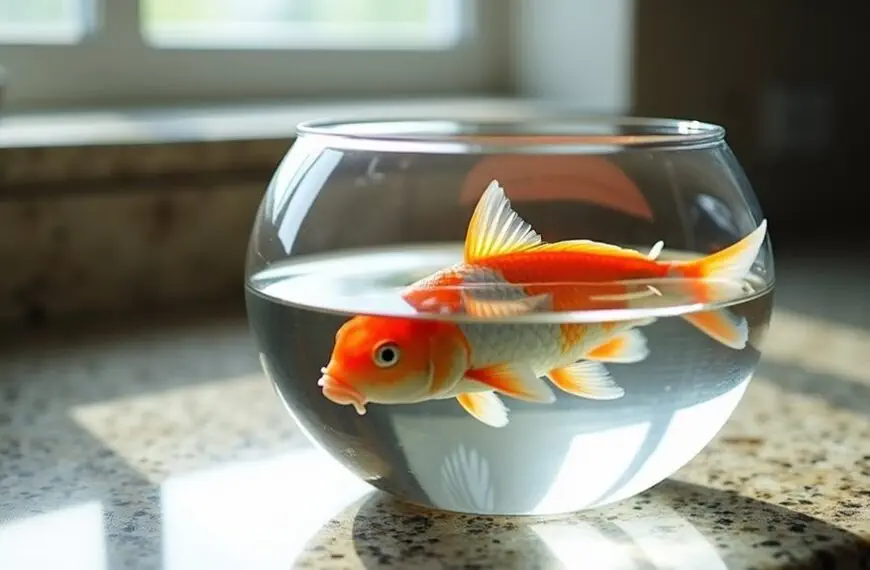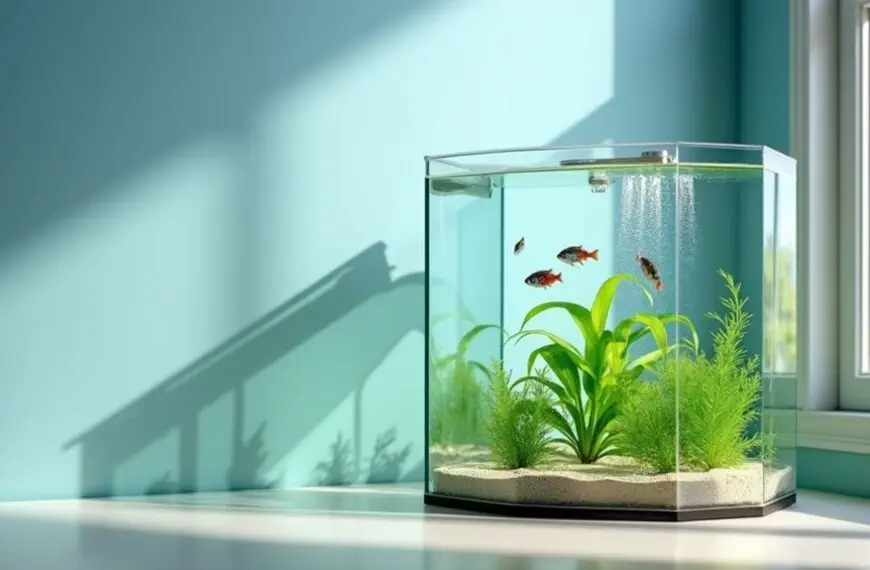You should keep your fish in the tank during routine cleaning tasks like water changes, algae removal, and gravel vacuuming. Moving fish to temporary housing creates unnecessary stress and can even harm them. Instead, use slow, gentle movements while cleaning to minimize disruption to your finned friends. When performing water changes, stick to replacing 10-20% weekly, and always verify new water matches the tank's temperature and pH levels. Keep your cleaning sessions brief and efficient, using aquarium-safe tools and cleaners. With the right approach and proper techniques, you'll discover how to maintain a sparkling tank while keeping your fish happy and healthy.
Contents
- 1 Types of Tank Cleaning
- 2 When to Remove Fish
- 3 Maintaining Fish Safety During Cleaning
- 4 Best Practices for Water Changes
- 5 Temporary Fish Housing Options
- 6 Essential Tank Cleaning Equipment
- 7 Safe Cleaning Solutions
- 8 Proper Cleaning Techniques
- 9 Frequently Asked Questions
- 9.1 How Long Can Fish Safely Stay in Temporary Containers During Cleaning?
- 9.2 Can Fish Get Sick From Being Transferred Between Tanks Too Often?
- 9.3 Should Medications Be Added to Temporary Holding Tanks During Cleaning?
- 9.4 How Do Different Species React to Being Left in During Cleaning?
- 9.5 What Signs Indicate a Fish Is Too Stressed During Cleaning?
- 10 Final Thoughts
Types of Tank Cleaning
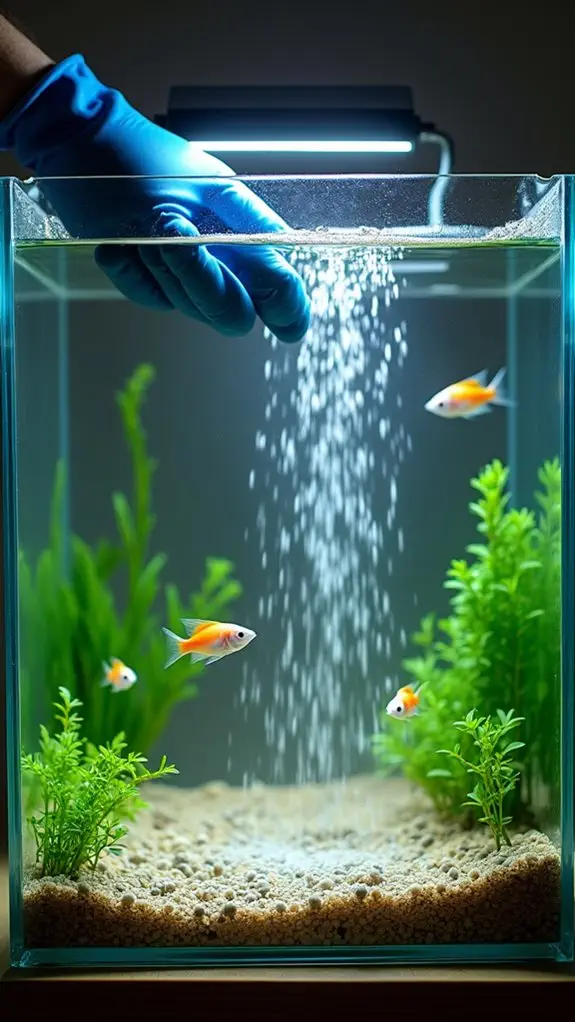
Regular tank cleaning involves several essential maintenance tasks that keep your aquarium healthy and vibrant. Understanding these different types of cleaning will help you maintain a thriving underwater environment for your finned friends.
Your tank maintenance routine should include regular algae management using the right tools. You'll want to use an aquarium-specific scraper or pad for glass tanks, and if you've got an acrylic tank, stick to plastic razors to avoid scratches. Monthly maintenance schedules are recommended for keeping your aquarium in optimal condition. Keeping your fish in the tank during cleaning helps prevent unnecessary stress. Maintaining optimal water quality is crucial for fish health and preventing stress during maintenance tasks.
Next, you'll need to tackle the gravel with a vacuum, which helps remove waste while doing a partial water change – just don't get carried away and remove more than 50% of the water at once!
Don't forget about those decorations and plants that make your tank beautiful. You can clean artificial items with hot water and a dedicated toothbrush, while live plants might need special care.
Finally, your filter needs attention too. When cleaning it, always use tank water to preserve those beneficial bacteria that keep your ecosystem balanced. Remember to unplug everything first – wet hands and electricity aren't exactly best friends!
When to Remove Fish
Sure! Here's the edited passage with an additional sentence:
During routine tank maintenance, you rarely need to remove your fish from their aquarium. Most cleaning tasks can be performed while your finned friends continue swimming about, which helps minimize fish stress and maintains their comfortable environment. Regular cleaning frequency actually helps prevent situations where you'd need to remove them. Using gentle cleaning techniques allows fish to remain calm during maintenance. Remember to unplug all equipment before starting any cleaning procedure. Additionally, maintaining regular water changes can further enhance fish comfort during routine tasks.
However, there are specific instances when you'll want to relocate your fish temporarily. If you notice a rotten egg smell coming from substrate less than 3 inches deep, that's a red flag indicating hydrogen sulfide – definitely time for fish to take a brief vacation!
You'll also need to move them if you're planning any major tank overhauls that involve complete water drainage or if you must use harsh cleaning chemicals (though that's rarely necessary with proper maintenance).
Watch your fish's behavior during cleaning sessions. If you're using a gravel vacuum or performing water changes, make sure they're swimming comfortably and not showing signs of distress.
Maintaining Fish Safety During Cleaning
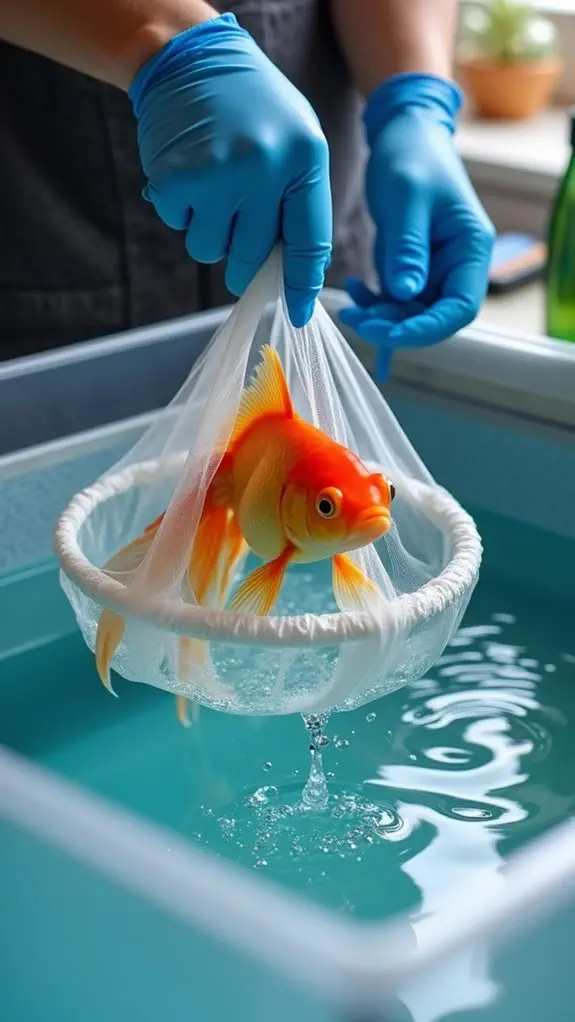
Maintaining your fish's safety and comfort during tank cleaning requires specific precautions and gentle techniques. To minimize fish stress, you'll want to move slowly and deliberately around your aquarium, treating your finned friends like the sensitive creatures they are.
Regular water changes and maintenance support optimal fish health, particularly by ensuring that the beneficial bacteria in the aquarium are preserved. Remember, your cleaning frequency shouldn't disrupt their peaceful environment too drastically.
When you're working in the tank, keep your movements gentle and controlled. You don't want to stir up a miniature underwater tornado that'll send your fish into a panic! Using an algae scraper pad designed specifically for your tank material will help prevent scratches and damage to the aquarium walls.
Use your gravel siphon carefully, always keeping an eye on where your fish are swimming to avoid accidentally sucking them up – trust me, they won't appreciate that impromptu roller coaster ride.
Make sure you're keeping at least half of the original tank water to maintain those beneficial bacteria that help keep your aquatic pals healthy. This practice stabilizes the nitrogen cycle and minimizes stress on your fish during cleaning.
Don't forget to monitor your water chemistry during cleaning, and never use cleaning products that could harm your fish.
Think of it like redecorating someone's home while they're still living in it – you want to be respectful and careful with every change you make.
Best Practices for Water Changes
When you're doing water changes, matching the temperature of the new water to your tank's water is essential since your fish can get stressed from sudden temperature shifts. It's also important to ensure that the pH levels of the new water match those of your tank to avoid stressing your fish due to sudden environment changes. You'll want to stick to a consistent schedule for water changes, as your finned friends thrive on routine and predictability. Regular water changes help prevent disease outbreaks and maintain your fish's immune system strength. Using a quality gravel vacuum will help you effectively remove debris and waste during the process. Small, frequent water changes of 10-15% work better than large ones because they're gentler on your fish and help maintain more stable water conditions in your tank.
Temperature Matching Matters Most
Every successful water change depends on matching your tank's temperature with the new water you're adding. While you don't need to be perfect down to the decimal point, you'll want to keep temperature fluctuations within 5 degrees to guarantee proper fish acclimation. Increased metabolic rates can lead to stress and health issues if temperatures fluctuate too much.
Think of it like jumping into a pool – you wouldn't want to plunge into freezing water when you're warm and cozy! Tank contents and rocks help maintain stable temperatures during water changes. Regular maintenance helps prevent harmful chemical buildup over time.
When preparing for a water change, you'll want to use separate buckets for your fresh and used water. Let your new water sit until it reaches room temperature, or use a reliable thermometer to match it with your tank's temperature.
If you're in a hurry, you can mix warm and cool water to reach the right temperature – just remember that your fish's comfort is worth the extra effort.
Your tank's heater will help stabilize any minor temperature differences, but don't rely on it too heavily. Sudden changes of 9-15°F can upset your fish's digestion, and larger swings could be fatal.
Consistent Schedule Prevents Stress
A consistent water change schedule stands as your fish tank's foundation for success. When you maintain regular water changes, you'll guarantee ideal water quality and promote better fish health in your aquarium. It's like giving your underwater friends a fresh, clean home every week!
To keep your fish happy and stress-free, aim to change 10-20% of the water weekly for most tanks. If you've got a larger aquarium, you can opt for a 25% change every two weeks.
While performing these changes, you'll want to use a gravel vacuum to remove waste and uneaten food that's settled at the bottom.
Remember to treat your new water with a dechlorinator before adding it to the tank, and add it gradually to prevent any sudden changes that could shock your fish. Maintaining optimal pH levels(6.5 to 7.5) in your aquarium is also crucial for the overall health of your fish.
When cleaning filter media, rinse it gently in the old tank water you've collected – this preserves beneficial bacteria while removing debris.
Small Changes Work Better
Making smaller, frequent water changes provides better stability for your aquarium than large, infrequent ones. When you make gradual changes of 10-15% weekly for smaller tanks or 20% for larger ones, you're helping your fish adapt more comfortably to their refreshed environment.
Think of it like slowly adjusting the temperature when you step into a pool – small adjustments are always more comfortable than sudden changes!
Your fish will thank you for taking this gentle approach, as it prevents stress and keeps their immune systems strong. By making these smaller water changes, you'll maintain consistent water parameters while removing harmful substances like nitrates and growth-inhibiting hormones.
Additionally, this routine helps in preserving the beneficial bacteria that are crucial for stabilizing the nitrogen cycle in your aquarium.
Remember to increase your water change percentages gradually, adding just 5-10% more at a time if you need larger changes. This method works especially well for heavily stocked tanks that might eventually need 30-50% weekly changes.
Temporary Fish Housing Options
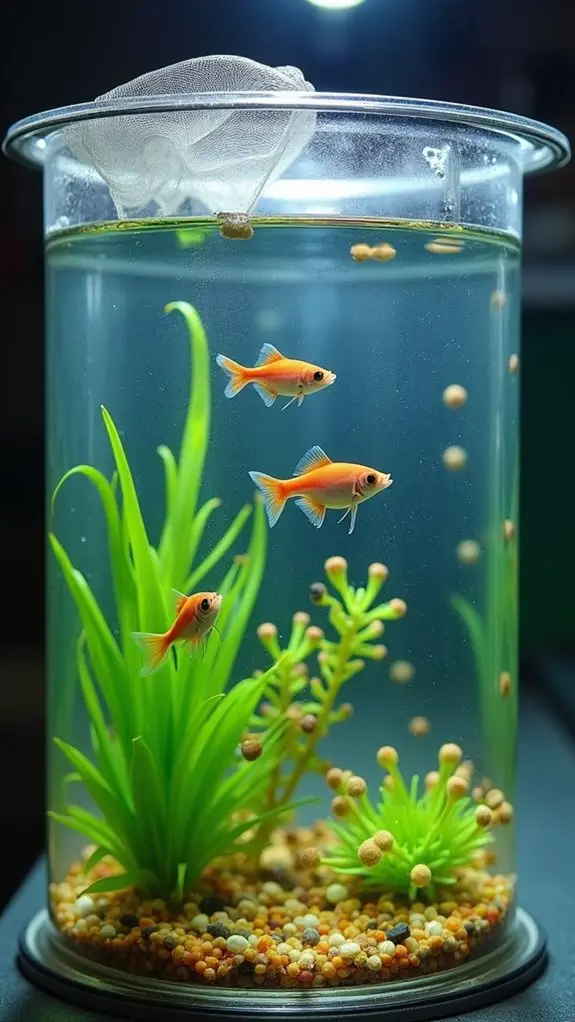
When it comes to housing fish during tank maintenance, several reliable options can keep your aquatic pets safe and comfortable. Your temporary fish housing needs to hold at least 10 liters of water, though you'll want to aim for 19 liters or more if you can.
Think of it as booking your fish a decent hotel room rather than cramming them into a tiny closet!
Food-grade containers and Rubbermaid tubs make excellent temporary homes, but you'll need to guarantee they're clean and chemical-free.
Don't forget to add basic equipment like an air stone or sponge filter to keep the water moving and healthy. Regular water tests are also important to ensure that ammonia and nitrite levels remain safe for your fish.
You'll want to place the container near a heat source in cooler climates to maintain comfortable temperatures for your finned friends.
Essential Tank Cleaning Equipment
Proper tank maintenance starts with having the right tools at your disposal. When it comes to essential supplies, you'll need different tools for various cleaning tasks, and having them ready will make your cleaning frequency much more manageable.
For general cleaning, you'll want a reliable gravel vacuum to remove waste and debris, along with algae scrapers to keep your tank walls crystal clear. Don't forget those arm-length gloves – nobody wants a surprise splash of tank water up their sleeve!
Filter maintenance requires specific tools like cleaning brushes and squeeze tools to keep your filtration system running smoothly. If you've got a glass tank, you'll need appropriate scrapers, while acrylic tanks require special magnetic cleaners to avoid scratches.
Think of these tools as your aquarium cleaning superhero utility belt! For water changes, you'll want to invest in quality water changers and gravel rakes – they're real back-savers. Additionally, maintaining regular partial water changes will help ensure optimal conditions in the tank.
And always keep absorbent floor protection nearby because, let's face it, spills happen to the best of us. With these tools in your arsenal, you'll be well-equipped to maintain a healthy environment for your aquatic friends.
Safe Cleaning Solutions
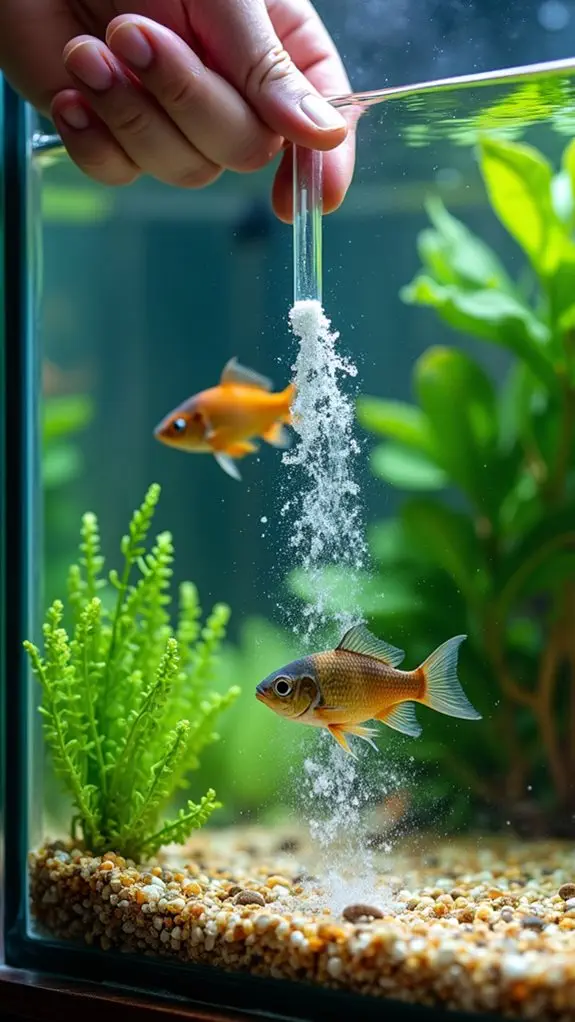
Selecting safe cleaning solutions for your aquarium is essential to protect your fish and maintain water quality. When choosing safe products, you'll want to take into account options like API Safe & Easy or Fritz Aquatics cleaners, which are specifically designed for aquarium use and won't harm your aquatic friends.
For the best cleaning effectiveness, you'll find that aquarium-specific cleaners can tackle those stubborn mineral deposits and algae buildup while leaving a protective coating that makes future maintenance easier.
If you're dealing with particularly tough residue, you might be tempted to reach for standard glass cleaners – but don't! These often contain ammonia and other toxins that can be deadly to your fish.
For external cleaning, magnetic scrapers are your best friends. They're like underwater window washers that keep you dry while doing the job!
While vinegar and bleach solutions can be effective, they should only be used when the tank is empty or on removable items that can be thoroughly rinsed. Always remember that maintaining a balanced ecosystem through regular water quality checks is crucial for your fish's overall well-being.
Remember to always use a dechlorinator after any bleach treatment – your fish will thank you for being so considerate of their living space!
Proper Cleaning Techniques
Before you start cleaning your tank, you'll want to gather your dedicated aquarium tools and guarantee everything's within arm's reach for a smooth process.
Getting your equipment ready means having your gravel vacuum, algae scraper, and water-holding bucket clean and ready to go, while making sure electrical components like filters and heaters are safely unplugged.
Once you're set up properly, you can begin cleaning with confidence, knowing you won't have to stop mid-task to search for something you need.
Equipment Setup and Preparation
To maintain a healthy aquarium environment, you'll need several essential tools and supplies before starting the cleaning process. Proper equipment organization will make your cleaning routine much more efficient and less stressful for both you and your aquatic friends.
Start by gathering your gravel siphon, algae scrubber, toothbrush, bucket, and water conditioner – think of it as assembling your aquarium cleaning toolkit!
Before diving into the actual cleaning, you'll want to boost your cleaning efficiency by setting everything up in a logical order. First, unplug all electrical equipment to keep things safe – nobody wants an unexpected zap!
Fill your bucket with fresh water and add the appropriate amount of water conditioner. While that's working its magic, you can prepare your cleaning tools. Make sure your gravel siphon isn't tangled (they love to do that, don't they?), and keep your algae scrubber handy for those stubborn green spots.
Having everything within arm's reach will help you maintain a smooth workflow and prevent any rushed decisions that could stress your fish.
Safe Cleaning Methods First
Now that your equipment is ready, let's get started with proper cleaning techniques that keep your fish safe and comfortable. Before you begin any safe cleaning procedures, remember to wash your hands thoroughly – your fish won't appreciate any lotion or soap residue in their home!
Next, unplug all electrical equipment to protect both you and your aquatic friends.
When it comes to fish protection during cleaning, you'll want to leave your finned pals right where they are. Start by using your gravel vacuum to remove waste and excess food, but don't get too enthusiastic – removing more than 50% of the water can stress your fish and disturb beneficial bacteria.
Gently clean the tank walls with appropriate scrubbers, being careful not to scratch the surface or startle your underwater community.
For filter maintenance, squeeze and rinse the media in a separate bucket filled with the water you've just removed from the tank. This preserves those helpful bacteria that keep your tank healthy.
Don't replace the filter media unless it's literally falling apart – it's like throwing away a perfectly good cleaning crew!
Frequently Asked Questions
How Long Can Fish Safely Stay in Temporary Containers During Cleaning?
You'll want to keep fish in temporary housing for no more than 1-2 hours to maintain good water quality. If you need longer, guarantee proper aeration and stable temperatures in their temporary container.
Can Fish Get Sick From Being Transferred Between Tanks Too Often?
Yes, you'll risk making your fish sick through frequent transfers. Their stress response weakens their immune system, leaving them vulnerable to diseases. Plus, constant environmental changes disrupt tank stability they need to thrive.
Should Medications Be Added to Temporary Holding Tanks During Cleaning?
You shouldn't add medications to temporary holding tanks during cleaning. Unstable tank conditions can reduce medication effectiveness and increase fish stress. Save treatments for your main aquarium or dedicated quarantine tanks instead.
How Do Different Species React to Being Left in During Cleaning?
You'll notice different fish behavior during cleaning. Some species remain calm, while others show stress indicators like hiding or rapid gill movement. Species compatibility affects reactions, with peaceful fish typically handling tank environment changes better.
What Signs Indicate a Fish Is Too Stressed During Cleaning?
You'll notice key stress signs when fish gasp at the surface, display erratic swimming, clamp their fins, or hide excessively during cleaning. Adjust your cleaning techniques if you observe these behaviors immediately.
Final Thoughts
You've now got all the tools you need to clean your aquarium like a pro! Remember, you don't always have to remove your fish during routine maintenance, but when you do, handle them with care and confidence. Whether you're doing a quick water change or deep cleaning, keeping your finned friends safe is priority number one. With proper equipment and techniques, you'll maintain a sparkling clean tank that your fish will love calling home.

